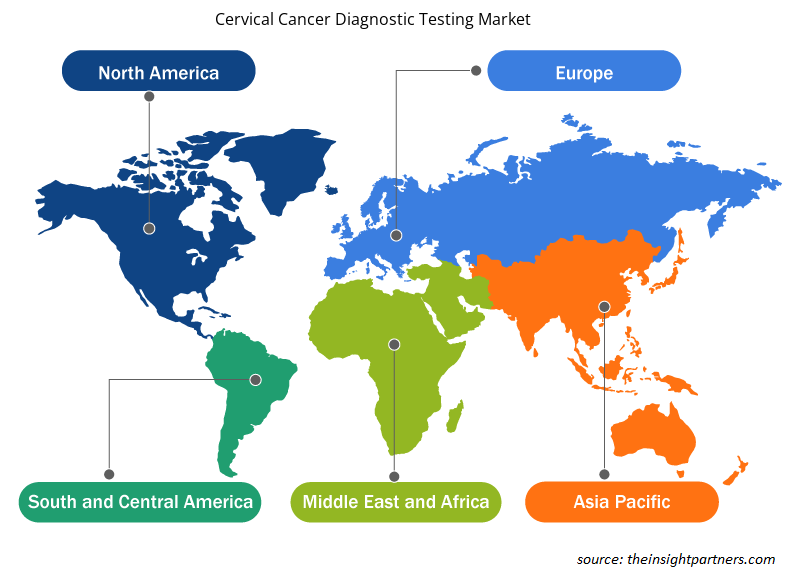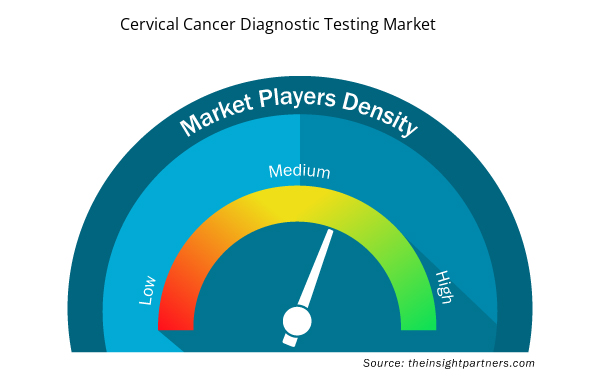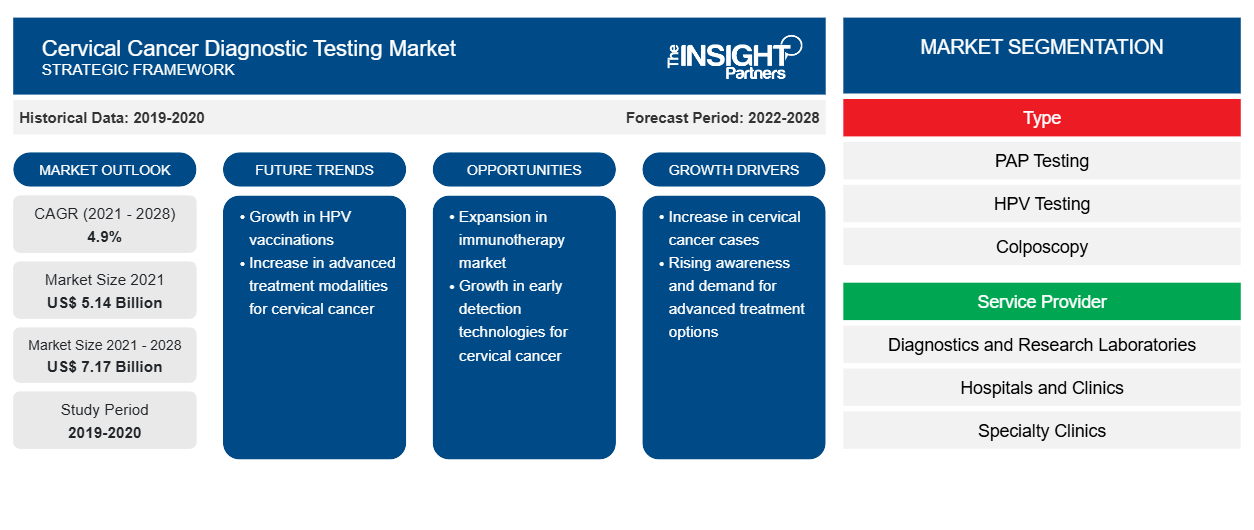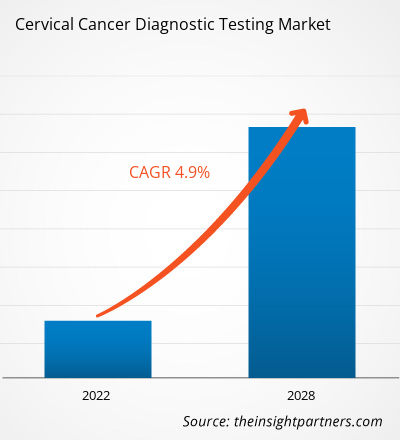Se proyecta que el mercado de pruebas de diagnóstico de cáncer de cuello uterino alcance los US$ 7.165,92 millones para 2028 desde los US$ 5.141,25 millones en 2021; se espera que crezca a una CAGR del 4,9% entre 2021 y 2028.
El cáncer de cuello uterino tiene una tasa de mortalidad significativa (casi el 50%), que se puede reducir con una detección y prevención tempranas. Las alteraciones precancerosas ofrecen oportunidades de prevención y tratamiento porque la progresión de la enfermedad suele retrasarse. Sin embargo, debido a la falta de conocimiento o acceso a servicios de diagnóstico, muchos casos se detectan en etapas más avanzadas de la progresión de la enfermedad. El virus del papiloma humano (VPH) es una causa primaria de cáncer de cuello uterino que generalmente se transmite por contacto sexual. Hay más de 100 cepas de VPH, y 13 de las cuales son de alto riesgo o cancerígenas. El gen activo - E6 o E7 - determina si una cepa de VPH es de alto o bajo riesgo. E6 se une a p53, causando destrucción proteolítica. E7, por otro lado, se une al retinoblastoma; la unión desplaza los factores de transcripción previamente unidos, lo que da como resultado que se detenga el ciclo celular y se inhiba la regulación de la apoptosis. La prueba del VPH detecta el virus del papiloma humano en las células del cuello uterino. Otros métodos de detección empleados en áreas de bajos recursos de los países en desarrollo son la prueba de ADN del VPH y la inspección visual. El examen de cuello uterino realizado periódicamente ayuda a la detección temprana del cáncer de cuello uterino, lo que reduce la tasa de mortalidad por esta enfermedad. Cada tres años, se recomienda a todas las mujeres de entre 21 y 65 años que se hagan una prueba de Papanicolaou, y a las mujeres de entre 30 y 65 años se les recomienda que se hagan una prueba de Papanicolaou y una prueba de VPH. En términos de ingresos, este tipo dominó el mercado de detección del cáncer de cuello uterino en 2021, y se espera que continúe su dominio durante el período de pronóstico.
Personalice este informe según sus necesidades
Obtendrá personalización en cualquier informe, sin cargo, incluidas partes de este informe o análisis a nivel de país, paquete de datos de Excel, así como también grandes ofertas y descuentos para empresas emergentes y universidades.
- Obtenga las principales tendencias clave del mercado de este informe.Esta muestra GRATUITA incluirá análisis de datos, desde tendencias del mercado hasta estimaciones y pronósticos.
Perspectivas de mercado
El aumento de la prevalencia del cáncer impulsará el crecimiento del mercado de pruebas de diagnóstico del cáncer de cuello uterino durante el período de pronóstico
El cáncer se ha convertido en una de las principales causas de muerte en todo el mundo. Según la Organización Mundial de la Salud (OMS), el cáncer fue la primera causa de muerte en personas menores de 70 años en 183 países y la cuarta causa de muerte en 123 países de todo el mundo en 2019. Además, según los datos publicados por la OMS en marzo de 2021, en 2020 se produjeron ~10 millones de muertes debido a diferentes tipos de cáncer. La creciente incidencia del cáncer de cuello uterino entre las mujeres de todo el mundo impulsa el crecimiento del mercado de pruebas de diagnóstico del cáncer de cuello uterino . Según la OMS, cada año se registran más de 270.000 muertes de mujeres por cáncer de cuello uterino. Las tasas de mortalidad por cáncer de cuello uterino son mayores en los países de bajos ingresos debido al diagnóstico tardío de la enfermedad. Se prevé que el mercado crezca en los próximos años debido a la creciente aceptación de las pruebas de diagnóstico del cáncer de cuello uterino para la detección temprana de la enfermedad.
La creciente prevalencia del cáncer ha creado una carga para los sistemas de atención sanitaria de todo el mundo. Según la Agencia Internacional para la Investigación sobre el Cáncer (IARC), se estima que la carga mundial de nuevos casos de cáncer alcanzará los 27,5 millones aproximadamente en 2040, y es probable que la enfermedad sea la causa de aproximadamente 163 millones de muertes para ese año. Factores como los cambios en el estilo de vida, el tabaquismo, la reducción de la actividad física y las condiciones climáticas y sanitarias inciertas conducirán a una carga aún mayor de cáncer en el mundo en los próximos años.
Perspectivas basadas en tipos
Según el tipo, el mercado de pruebas de diagnóstico de cáncer de cuello uterino se segmenta en pruebas de Papanicolaou, pruebas de VPH , colposcopia, biopsias de cuello uterino, cistoscopia y otras. En 2021, el segmento de pruebas de Papanicolaou tuvo la mayor participación del mercado y se estima que registrará la CAGR más alta durante 2021-2028.
Información basada en proveedores de servicios
Según el proveedor de servicios, el mercado está segmentado en laboratorios de investigación, diagnóstico e investigación, hospitales y clínicas, clínicas especializadas y servicios de atención domiciliaria. En 2021, el segmento de laboratorios de diagnóstico e investigación tuvo la mayor participación del mercado y se espera que registre la CAGR más alta del mercado durante 2021-2028.
Las empresas que operan en el mercado de pruebas de diagnóstico de cáncer de cuello uterino están adoptando diversas estrategias, como innovaciones de productos, para satisfacer las cambiantes demandas de los clientes en todo el mundo y mantener su marca en el mercado global.
Segmentación del mercado de pruebas de diagnóstico del cáncer de cuello uterino
El mercado de pruebas de diagnóstico de cáncer de cuello uterino está segmentado en función del tipo y del proveedor de servicios. Según el tipo, el mercado se subsegmenta en pruebas de Papanicolaou, pruebas de VPH, colposcopia, biopsias de cuello uterino, cistoscopia y otras. Según el proveedor de servicios, el mercado se segmenta aún más en laboratorios de diagnóstico e investigación, hospitales y clínicas, clínicas especializadas y servicios de atención domiciliaria.
En términos geográficos, el mercado de pruebas de diagnóstico de cáncer de cuello uterino está segmentado en América del Norte (EE. UU., Canadá y México), Europa (Francia, Alemania, Italia, Reino Unido, España y el resto de Europa), Asia Pacífico (Australia, China, India, Japón, Corea del Sur y el resto de APAC), Oriente Medio y África (Arabia Saudita, Sudáfrica, Emiratos Árabes Unidos y el resto de MEA) y América del Sur y Central (Brasil, Argentina y el resto de SCAM).
Perspectivas regionales del mercado de pruebas de diagnóstico del cáncer de cuello uterino
Los analistas de Insight Partners explicaron en detalle las tendencias y los factores regionales que influyen en el mercado de pruebas de diagnóstico de cáncer de cuello uterino durante el período de pronóstico. Esta sección también analiza los segmentos y la geografía del mercado de pruebas de diagnóstico de cáncer de cuello uterino en América del Norte, Europa, Asia Pacífico, Oriente Medio y África, y América del Sur y Central.

- Obtenga datos regionales específicos para el mercado de pruebas de diagnóstico de cáncer de cuello uterino
Alcance del informe de mercado de pruebas de diagnóstico de cáncer de cuello uterino
| Atributo del informe | Detalles |
|---|---|
| Tamaño del mercado en 2021 | 5.140 millones de dólares estadounidenses |
| Tamaño del mercado en 2028 | 7.170 millones de dólares estadounidenses |
| CAGR global (2021-2028) | 4,9% |
| Datos históricos | 2019-2020 |
| Período de pronóstico | 2022-2028 |
| Segmentos cubiertos | Por tipo
|
| Regiones y países cubiertos | América del norte
|
| Líderes del mercado y perfiles de empresas clave |
|
Densidad de actores del mercado de pruebas de diagnóstico de cáncer de cuello uterino: comprensión de su impacto en la dinámica empresarial
El mercado de pruebas de diagnóstico de cáncer de cuello uterino está creciendo rápidamente, impulsado por la creciente demanda de los usuarios finales debido a factores como la evolución de las preferencias de los consumidores, los avances tecnológicos y una mayor conciencia de los beneficios del producto. A medida que aumenta la demanda, las empresas amplían sus ofertas, innovan para satisfacer las necesidades de los consumidores y aprovechan las tendencias emergentes, lo que impulsa aún más el crecimiento del mercado.
La densidad de actores del mercado se refiere a la distribución de las empresas o firmas que operan dentro de un mercado o industria en particular. Indica cuántos competidores (actores del mercado) están presentes en un espacio de mercado determinado en relación con su tamaño o valor total de mercado.
Las principales empresas que operan en el mercado de pruebas de diagnóstico de cáncer de cuello uterino son:
- F. HOFFMANN-LA ROCHE LTD.
- Abad
- Quest Diagnostics Incorporated
- QIAGEN
- Fabricante: Hologic, Inc.
Descargo de responsabilidad : Las empresas enumeradas anteriormente no están clasificadas en ningún orden particular.

- Obtenga una descripción general de los principales actores clave del mercado de pruebas de diagnóstico de cáncer de cuello uterino
Perfiles de empresas
- F. Hoffmann-La Roche Ltd.
- Abad
- Quest Diagnostics Incorporated
- QIAGEN
- Fabricante: Hologic, Inc.
- DYSIS Médica Inc.
- Compañía: Femasys Inc.
- Terapéutica guiada, Inc.
- Compañías Cooper, Inc.
- BD
- Análisis histórico (2 años), año base, pronóstico (7 años) con CAGR
- Análisis PEST y FODA
- Tamaño del mercado Valor/volumen: global, regional, nacional
- Industria y panorama competitivo
- Conjunto de datos de Excel


- Fishing Equipment Market
- Electronic Data Interchange Market
- Employment Screening Services Market
- Hair Extensions Market
- Bathroom Vanities Market
- Water Pipeline Leak Detection System Market
- Foot Orthotic Insoles Market
- Rugged Servers Market
- Portable Power Station Market
- Advanced Planning and Scheduling Software Market

Report Coverage
Revenue forecast, Company Analysis, Industry landscape, Growth factors, and Trends

Segment Covered
This text is related
to segments covered.

Regional Scope
North America, Europe, Asia Pacific, Middle East & Africa, South & Central America

Country Scope
This text is related
to country scope.
Preguntas frecuentes
Asia Pacific is registered as the fastest-growing region in the global cervical cancer diagnostic testing market. The market is this region is expected to grow significantly in countries such as China, Japan, and India. The market is driven by the increasing prevalence of cervical cancer in developing countries, including China, India, Malaysia, Japan, South Korea, and Australia.
The cervical cancer diagnostic testing market based on type is segmented into PAP testing, HPV testing, colposcopy, cervical biopsies, cystoscopy, others. In 2021, the PAP Testing segment accounted for the highest share. Besides, the HPV testing segment is expected to grow at a CAGR of 5.5% in the forecast period.
The global cervical cancer diagnostic testing market is segmented into North America, Europe, Asia Pacific, Middle East & Africa, and South & Central America. The North American area holds the largest market for aesthetic skin devices. The United States held the most significant cervical cancer diagnostic testing market and is expected to grow due to factors such as high awareness about disease prevention among women in the region, as well as to the many initiatives launched to prevent cervical cancer, which have increased the reach of insurance coverage for cervical screening tests, especially for low-income women, and others.
The cervical cancer diagnostic testing market majorly consists of the players such as as F. Hoffmann-La Roche Ltd., Abbott, Quest Diagnostics Incorporated, QIAGEN, Hologic, Inc., DYSIS Medical Inc., Femasys Inc., Guided Therapeutics, Inc, Cooper Companies, Inc., BD are amongst others.
Cervical Cancer refers to cancer that occurs in the cells of the cervix i.e. the lower part of the uterus that connects to the vagina. In 90% of the cases, cervical malignancies occur due to the HPV infection and are diagnosed through smear screening.
The factors that are driving and restraining factors that will affect the cervical cancer diagnostic testing market in the coming years. Factors such as the increasing prevalence of cancer and the rise in HPV infections are driving the market growth. However, less number of commercially available vaccines for the treatment of cancer are likely to hamper the growth of the market.
Trends and growth analysis reports related to Life Sciences : READ MORE..
The List of Companies - Cervical Cancer Diagnostic Testing Market
- F. HOFFMANN-LA ROCHE LTD.
- Abbott
- Quest Diagnostics Incorporated
- QIAGEN
- Hologic, Inc.
- DYSIS Medical Inc
- Femasys Inc.
- GUIDED THERAPEUTICS, INC
- Cooper Companies, Inc.
- BD
The Insight Partners performs research in 4 major stages: Data Collection & Secondary Research, Primary Research, Data Analysis and Data Triangulation & Final Review.
- Data Collection and Secondary Research:
As a market research and consulting firm operating from a decade, we have published and advised several client across the globe. First step for any study will start with an assessment of currently available data and insights from existing reports. Further, historical and current market information is collected from Investor Presentations, Annual Reports, SEC Filings, etc., and other information related to company’s performance and market positioning are gathered from Paid Databases (Factiva, Hoovers, and Reuters) and various other publications available in public domain.
Several associations trade associates, technical forums, institutes, societies and organization are accessed to gain technical as well as market related insights through their publications such as research papers, blogs and press releases related to the studies are referred to get cues about the market. Further, white papers, journals, magazines, and other news articles published in last 3 years are scrutinized and analyzed to understand the current market trends.
- Primary Research:
The primarily interview analysis comprise of data obtained from industry participants interview and answers to survey questions gathered by in-house primary team.
For primary research, interviews are conducted with industry experts/CEOs/Marketing Managers/VPs/Subject Matter Experts from both demand and supply side to get a 360-degree view of the market. The primary team conducts several interviews based on the complexity of the markets to understand the various market trends and dynamics which makes research more credible and precise.
A typical research interview fulfils the following functions:
- Provides first-hand information on the market size, market trends, growth trends, competitive landscape, and outlook
- Validates and strengthens in-house secondary research findings
- Develops the analysis team’s expertise and market understanding
Primary research involves email interactions and telephone interviews for each market, category, segment, and sub-segment across geographies. The participants who typically take part in such a process include, but are not limited to:
- Industry participants: VPs, business development managers, market intelligence managers and national sales managers
- Outside experts: Valuation experts, research analysts and key opinion leaders specializing in the electronics and semiconductor industry.
Below is the breakup of our primary respondents by company, designation, and region:

Once we receive the confirmation from primary research sources or primary respondents, we finalize the base year market estimation and forecast the data as per the macroeconomic and microeconomic factors assessed during data collection.
- Data Analysis:
Once data is validated through both secondary as well as primary respondents, we finalize the market estimations by hypothesis formulation and factor analysis at regional and country level.
- Macro-Economic Factor Analysis:
We analyse macroeconomic indicators such the gross domestic product (GDP), increase in the demand for goods and services across industries, technological advancement, regional economic growth, governmental policies, the influence of COVID-19, PEST analysis, and other aspects. This analysis aids in setting benchmarks for various nations/regions and approximating market splits. Additionally, the general trend of the aforementioned components aid in determining the market's development possibilities.
- Country Level Data:
Various factors that are especially aligned to the country are taken into account to determine the market size for a certain area and country, including the presence of vendors, such as headquarters and offices, the country's GDP, demand patterns, and industry growth. To comprehend the market dynamics for the nation, a number of growth variables, inhibitors, application areas, and current market trends are researched. The aforementioned elements aid in determining the country's overall market's growth potential.
- Company Profile:
The “Table of Contents” is formulated by listing and analyzing more than 25 - 30 companies operating in the market ecosystem across geographies. However, we profile only 10 companies as a standard practice in our syndicate reports. These 10 companies comprise leading, emerging, and regional players. Nonetheless, our analysis is not restricted to the 10 listed companies, we also analyze other companies present in the market to develop a holistic view and understand the prevailing trends. The “Company Profiles” section in the report covers key facts, business description, products & services, financial information, SWOT analysis, and key developments. The financial information presented is extracted from the annual reports and official documents of the publicly listed companies. Upon collecting the information for the sections of respective companies, we verify them via various primary sources and then compile the data in respective company profiles. The company level information helps us in deriving the base number as well as in forecasting the market size.
- Developing Base Number:
Aggregation of sales statistics (2020-2022) and macro-economic factor, and other secondary and primary research insights are utilized to arrive at base number and related market shares for 2022. The data gaps are identified in this step and relevant market data is analyzed, collected from paid primary interviews or databases. On finalizing the base year market size, forecasts are developed on the basis of macro-economic, industry and market growth factors and company level analysis.
- Data Triangulation and Final Review:
The market findings and base year market size calculations are validated from supply as well as demand side. Demand side validations are based on macro-economic factor analysis and benchmarks for respective regions and countries. In case of supply side validations, revenues of major companies are estimated (in case not available) based on industry benchmark, approximate number of employees, product portfolio, and primary interviews revenues are gathered. Further revenue from target product/service segment is assessed to avoid overshooting of market statistics. In case of heavy deviations between supply and demand side values, all thes steps are repeated to achieve synchronization.
We follow an iterative model, wherein we share our research findings with Subject Matter Experts (SME’s) and Key Opinion Leaders (KOLs) until consensus view of the market is not formulated – this model negates any drastic deviation in the opinions of experts. Only validated and universally acceptable research findings are quoted in our reports.
We have important check points that we use to validate our research findings – which we call – data triangulation, where we validate the information, we generate from secondary sources with primary interviews and then we re-validate with our internal data bases and Subject matter experts. This comprehensive model enables us to deliver high quality, reliable data in shortest possible time.


 Obtenga una muestra gratuita de este informe
Obtenga una muestra gratuita de este informe